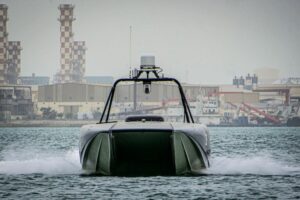The Navy is readying to scale its use of unmanned systems to the fleet level, with senior leaders announcing plans Tuesday to begin with expanding the effort to the Fourth Fleet in Central and South America this July.
Navy Secretary Carlos Del Toro and Adm. Mike Gilday, Chief of Naval Operations, announced the service will build off the Central Command-based Task Force 59’s success in recent years to advance integration of unmanned capabilities.

“We’re ready to expand our unmanned platforms beyond the Middle East. And today, in front of all of you, I’m pleased to announce that we will scale unmanned platforms to the fleet level and the Fourth Fleet as well,” Del Toro told attendees at the Navy Leagues’ Sea Air Space conference in National Harbor, Md. “The Fourth Fleet area of operations provides us with an environment best suited to operationalize the concepts of Task Force 59, that’s worked tirelessly to develop [and] increase our maritime domain awareness, or MDA, capabilities.”
Gilday confirmed to reporters following his discussion alongside Del Toro that the initiative will not involve standing up a new, separate task force within Fourth Fleet, which is based in the U.S. Southern Command area of responsibility (AOR), but will look to integrate capabilities and concepts of operation within the existing command structure.
“We want to scale this south. The Southern Command AOR seemed like a perfect environment for us to do this and to get after, as the secretary mentioned, those real world missions that we’re responsible for, with respect to counter-trafficking as well as the illegal and unregulated fishing,” Gilday told reporters.
The expansion to Fourth Fleet will begin this July with integrating unmanned capabilities into the upcoming UNITAS exercise, Gilday and Del Toro noted.
The Navy Fifth Fleet’s Task Force 59 was established in September 2021 to help test and integrate unmanned systems and artificial intelligence into the service (Defense Daily, Sept. 9, 2021).
Task Force 59 conducted almost 20 exercises and included participation from six nations, Gilday noted, adding the goal was to get 100 unmanned platforms established in the CENTCOM region by this July.
“What we’ve been able to do with Task Force 59 is to make investments upfront, to test and to prototype, to understand the problem set, to understand the ecosystem in which [these unmanned systems] will operate. [And it] brings together the very best in platform engineers and software designers so that we can make magic happen and improve maritime domain awareness in the Middle East,” Gilday said. “It’s been rapid. Industry’s been focused. It’s been purposeful experimentation to solve operational problems and inform our acquisition strategies.”
Del Toro said the effort to scale the Navy’s unmanned initiative will open opportunities for industry, specifically citing the benefit of the open architecture mesh network powering these capabilities allowing for easier insertion of new capabilities.
“This is a great opportunity for businesses, small, medium and large, to really engage because this mesh network…is an open architecture network, irrespective of the actual drone of what’s in the air, on the surface or subsurface, it’s all feeding the same open architected mesh network. So you can come to the table with your own creativity, your own innovativeness and contribute,” Del Toro said.
Del Toro said having unmanned capabilities in the SOUTHCOM area of responsibility with Fourth Fleet can help bolster maritime domain awareness capabilities for countering drug and human trafficking as well as challenges with illegal fishing operations.
“Additionally, bringing these platforms and technologies to the Fourth Fleet sends a strong signal to our Caribbean, or Latin and South American partners, we are committed to their national and economic security, and that we’re investing resources into addressing the challenges we all face in the region together,” Del Toro said. “The sustained presence of these unmanned platforms provides us with the endurance and reach necessary to complement the activities of our manned platforms, freeing them up for other missions”